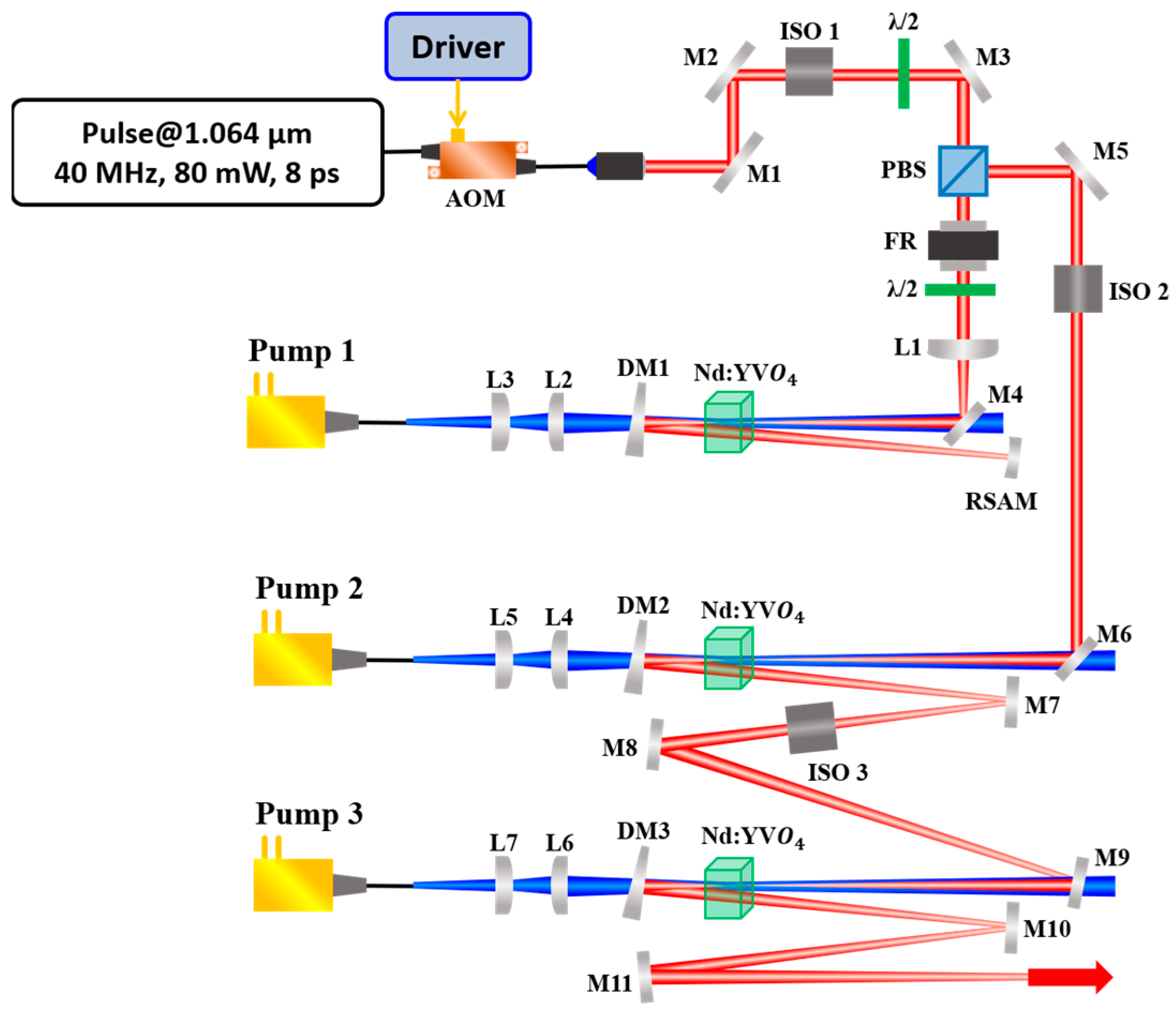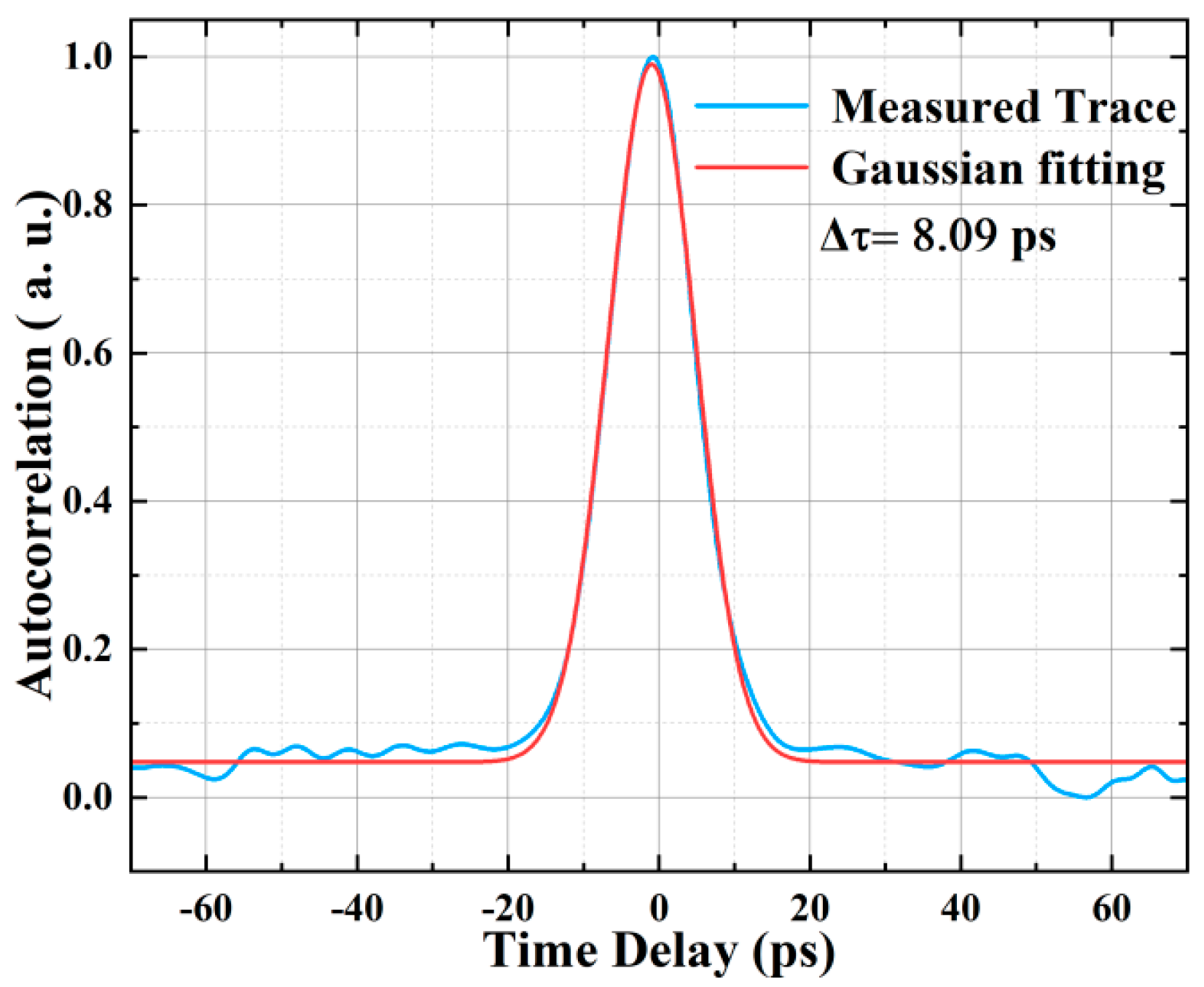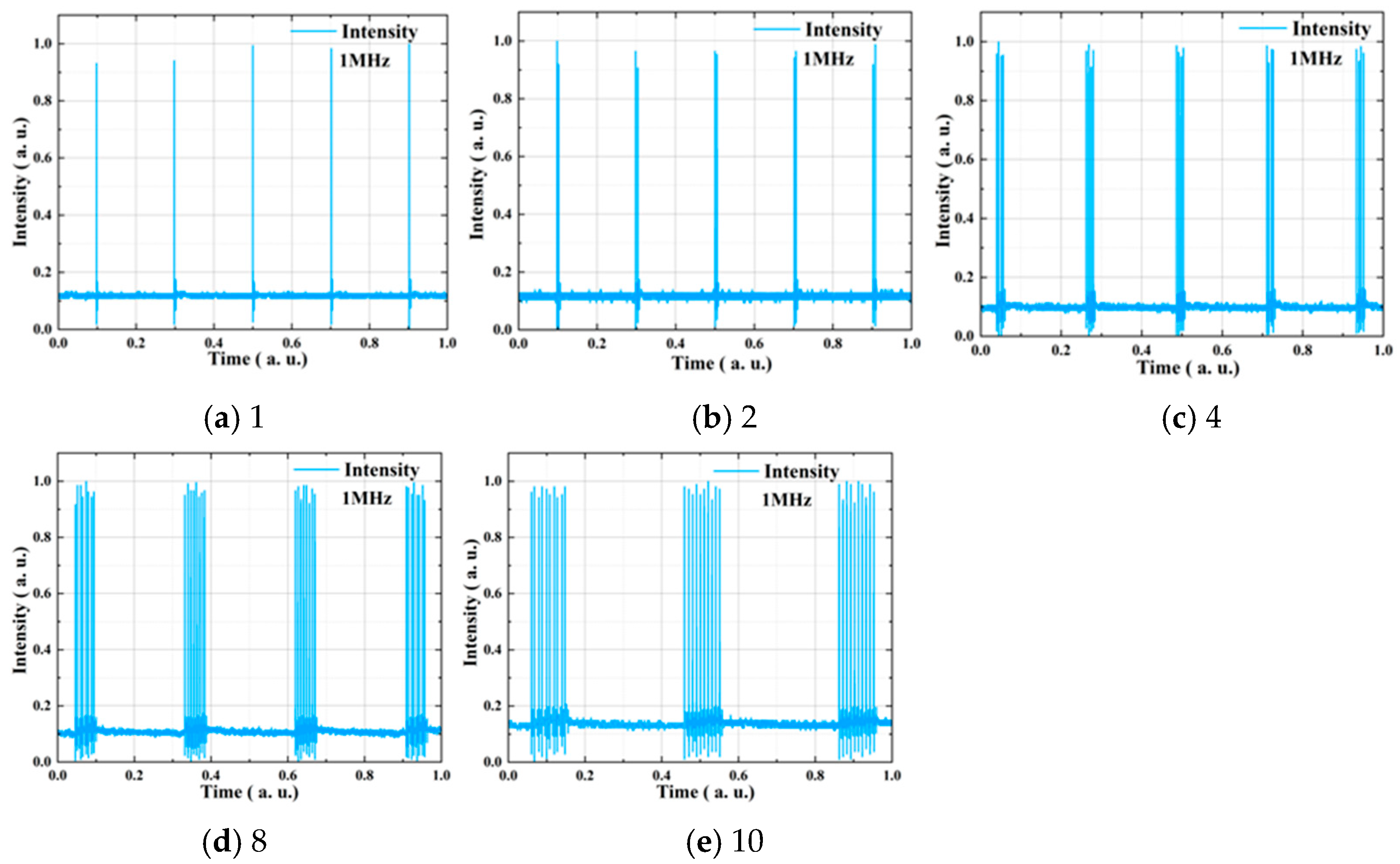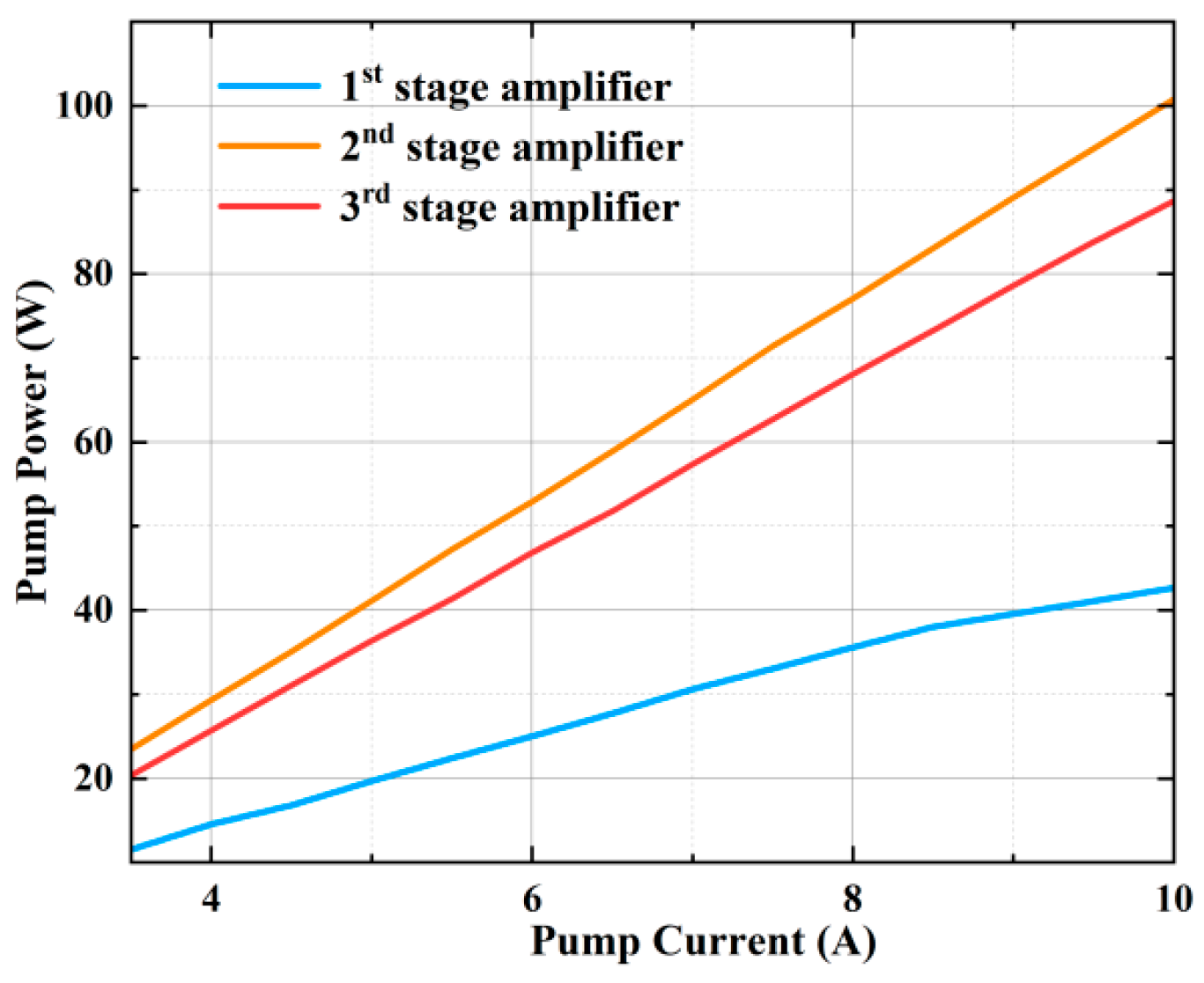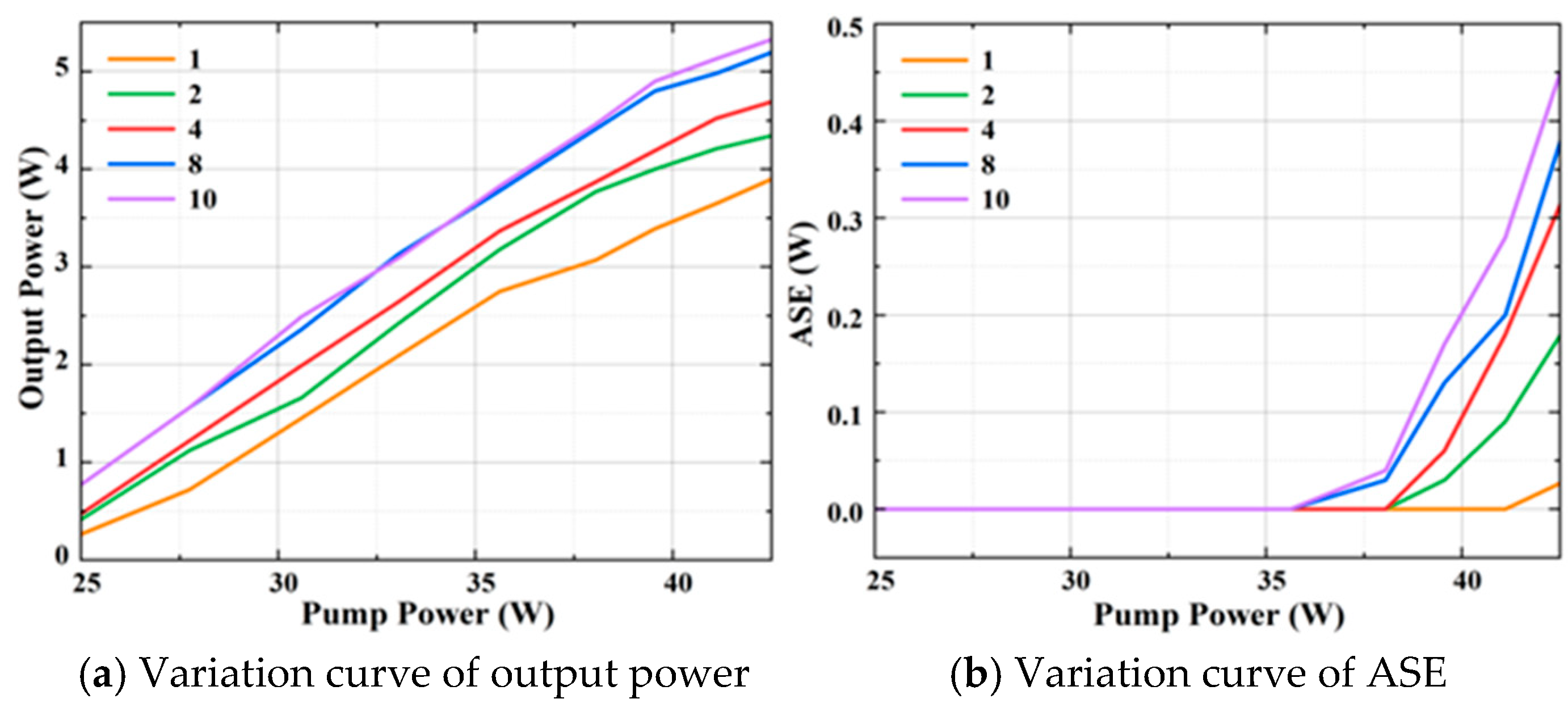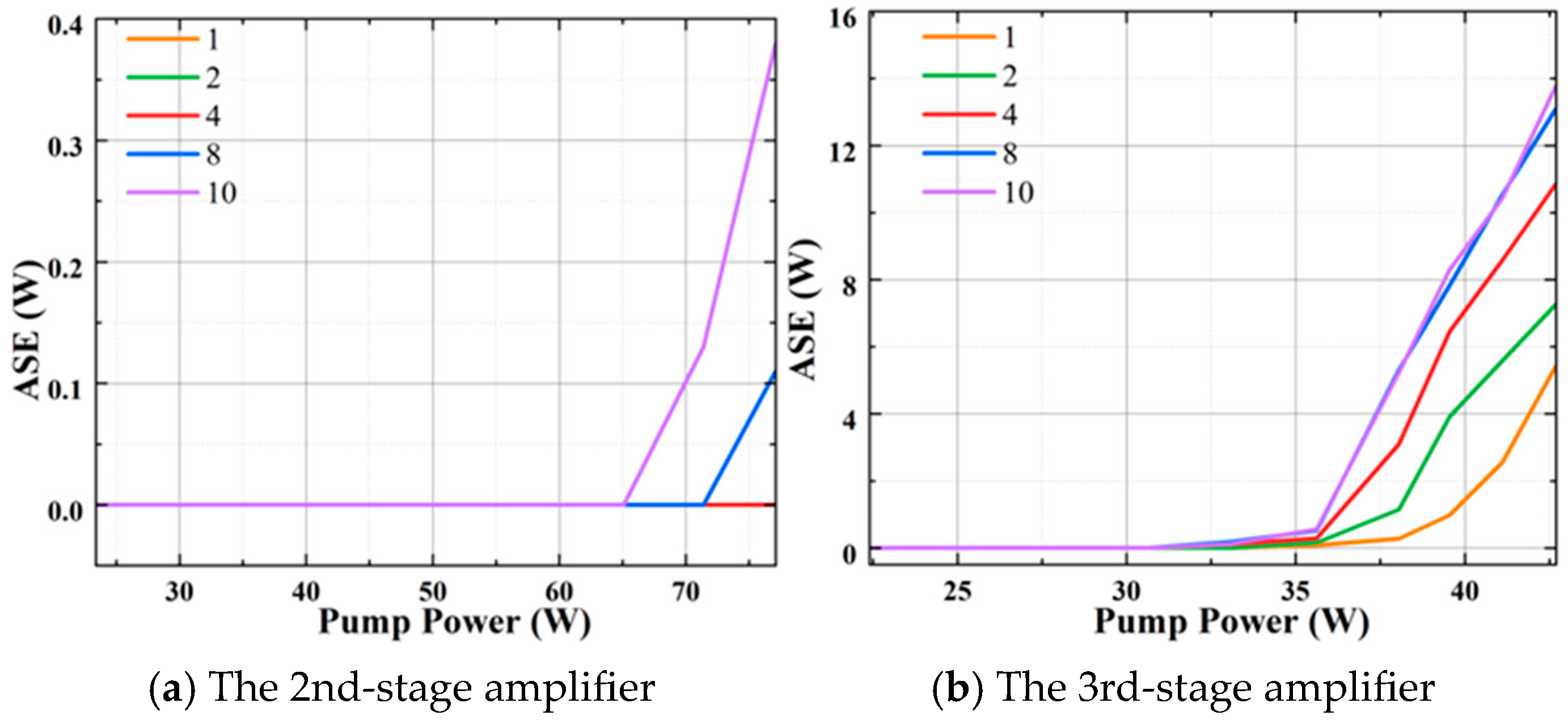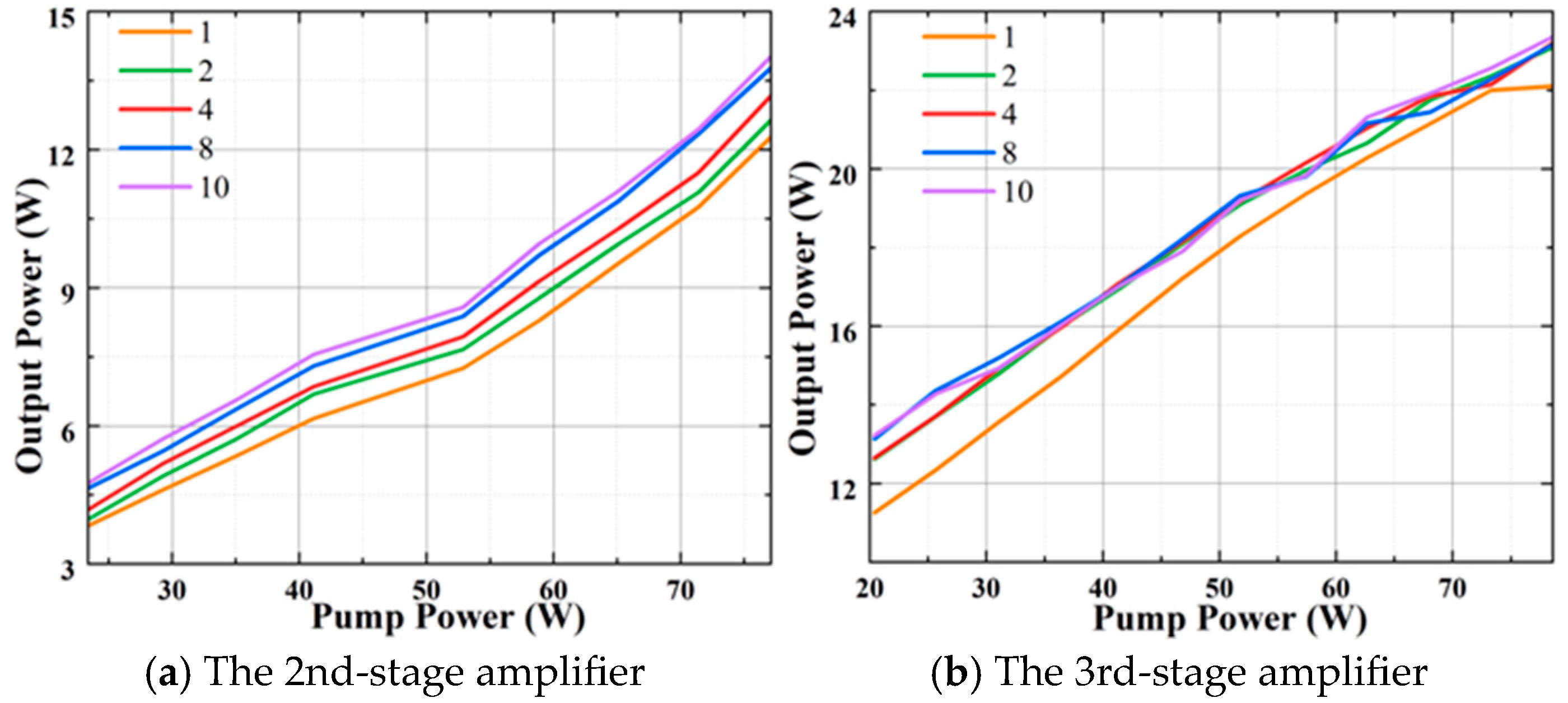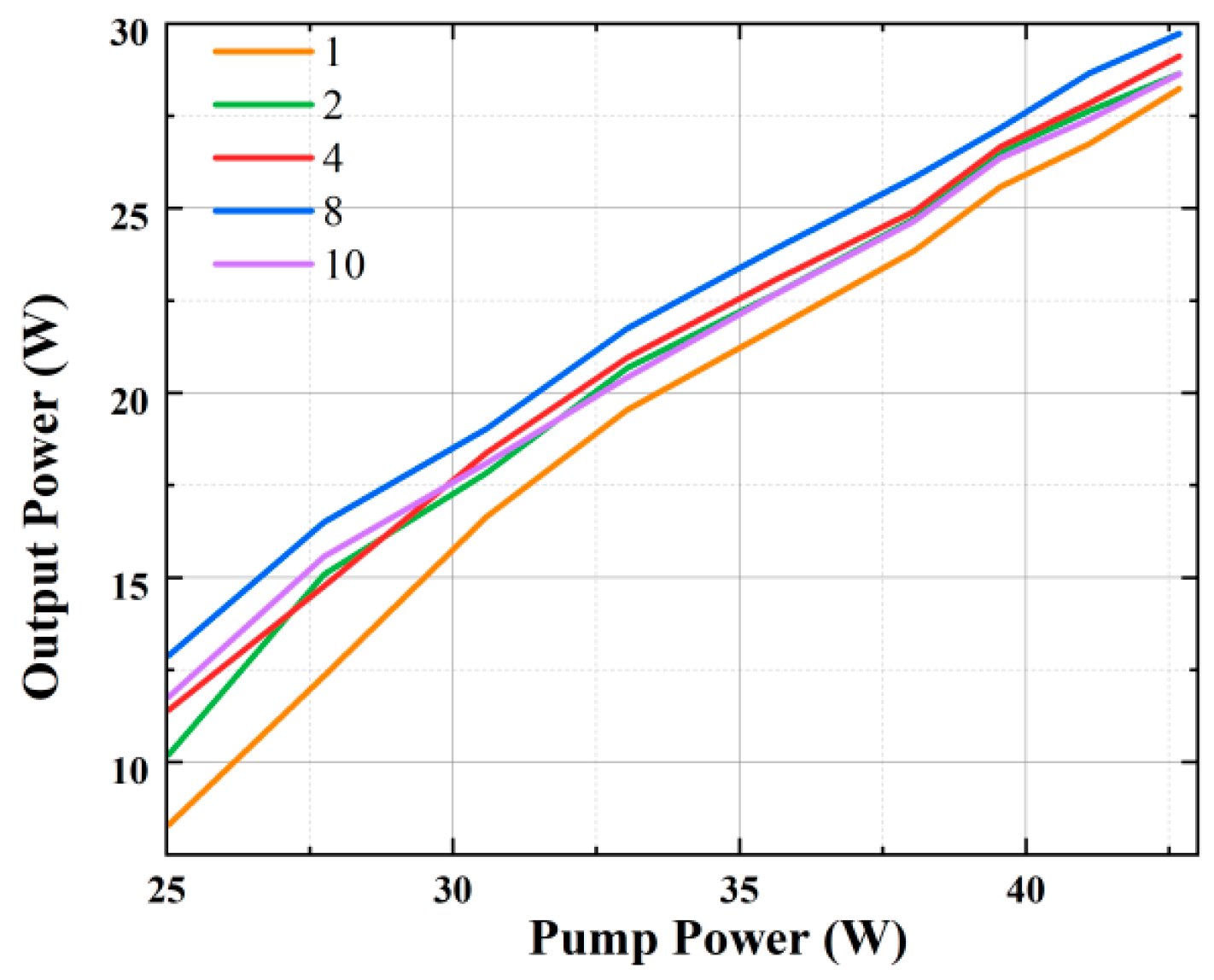1. Introduction
Picosecond green lasers with high pulse energy and high average power have important applications in many fields [
1,
2,
3,
4]. Compared with picosecond lasers with only one pulse (single pulse) per cycle at a certain repetition frequency, pulse train lasers composed of multiple picosecond pulses spaced in the nanosecond order have great application advantages. For short pulses with low pulse energies, multi-pass high gain amplification is often required first. Due to the obvious advantages in research and industry in recent years [
5,
6,
7,
8], a large number of picosecond lasers with high power and high repetition rate have been studied [
9,
10,
11], especially lasers with good beam quality and narrow pulse width.
A master oscillator power amplifier (MOPA) is a common method for achieving high-power lasers with good beam quality. The low-power seed laser is amplified by cascaded amplifiers to increase the output power [
12,
13,
14]. Fiber seed lasers and amplifiers have inherent advantages in MOPA systems [
15,
16]. Simplicity, reliability, low cooling requirements, and near-diffraction limited beam quality make it widely used. Fiber seeders have limited pulse peak power due to the characteristics of optical fibers. Nonlinear effects in the fiber (such as self-phase modulation and stimulated Raman scattering) and the low optical damage threshold caused by the small core diameter of the fiber contribute to most of the limitations.
Additionally, the limited pulse peak power of fiber seeders in MOPA systems necessitates the use of multiple stages of amplification to achieve the desired high-power output. Each amplifier stage further boosts the signal while maintaining the beam quality inherited from the initial fiber seed laser. Recent advances in thermal aberration compensation, such as the integration of a 4f system with a 0° reflector in Nd:YAG amplifiers, have demonstrated 73.7 mJ pulse energy with near-Gaussian beam quality (M
2 < 1.37) under 60.7 W pumping, effectively mitigating spherical aberration-induced beam degradation [
17]. This cascading approach allows for the construction of laser systems capable of delivering kilowatt-level average powers with excellent beam characteristics.
To address the limitation of pulse peak power in fiber seeders, advanced techniques such as chirped pulse amplification (CPA) [
18] are often incorporated into MOPA designs. This method effectively distributes the energy over a longer time frame, thereby reducing the peak power requirements of each amplifier stage and mitigating potential damage to the optical fibers [
19,
20]. Furthermore, dual-frequency MOPA architectures leveraging nonplanar ring oscillator (NPRO) seeds and ytterbium-doped fiber amplifiers (YDFAs) have achieved 5 W output at 1064 nm with ultra-low phase noise (−116.6 dBc/Hz at 10 kHz), enabling high-precision applications in photonic microwave generation and optical carrier light detection and ranging (LiDAR) [
21].
While the limited pulse peak power of fiber seeders presents a constraint in MOPA systems, the inherent advantages of fiber-based technology, combined with innovative amplification techniques and advancements in fiber design, have made it possible to overcome this limitation. These developments have paved the way for the creation of high-power lasers with excellent beam quality, making MOPA systems an indispensable tool in various fields such as materials processing, medical applications, and scientific research. In view of the performance advantages and potential application values, in this research, we use a fiber solid system composed of an optical fiber seeder, pulse selector, and solid-state amplifier to achieve high peak power output of the pulse train. This solid-state system overcomes nonlinear effects such as stimulated Raman scattering and self-phase modulation inside the fiber [
22,
23], making it very favorable for use in practice.
2. Basic Theory of the Nd:YVO4 Laser Amplifier System
The basic theory of the Nd:YVO4 laser amplifier system involves ultrashort pulse propagation in fiber seed lasers, pulse picking using an acousto-optic modulator (AOM) and gain dynamics in Nd:YVO4 amplifiers to achieve high peak powers.
2.1. Pulse Propagation and Nonlinear Effects in the Fiber Seed Laser
Ultrashort pulses generated in a mode-locked fiber laser propagate under the combined influence of dispersion and nonlinearity. Their evolution can be described by the nonlinear Schrödinger equation (NLSE)
where
is the slowly varying pulse envelope, and
is the group velocity dispersion (GVD) parameter given by
where
is the angular frequency and
is the wave number.
is the nonlinear coefficient given by
where
is the nonlinear refractive index,
is the operating wavelength, and
is the fiber’s effective mode area.
A key nonlinear effect influencing pulse evolution is self-phase modulation (SPM), which introduces an intensity-dependent phase shift
where
is the effective fiber length and
is the instantaneous intensity. This results in spectral broadening, which is crucial for pulse shaping and compression.
2.2. Pulse Picking Using an Acousto-Optic Modulator
To reduce the seed laser’s repetition rate, an AOM is used as a pulse picker. The AOM operates based on Bragg diffraction, governed by the Bragg condition
where
is the refractive index of the AOM medium,
is the acoustic wavelength, and
is the Bragg angle. The diffraction efficiency
, which determines how much light is deflected into the desired diffraction order, is given by
where
is the refractive index modulation induced by the acoustic wave and
is the interaction length. By adjusting the acoustic drive parameters, the AOM effectively selects pulses to achieve a lower repetition rate.
2.3. Gain Dynamics in Nd:YVO4 Amplifiers
After pulse picking, the lower-repetition-rate pulse train is amplified using a solid-state three-stage Nd:YVO
4 amplifier system. The gain mechanism in Nd:YVO
4 amplifiers follows the population inversion model, where the small-signal gain coefficient
is
where
and
are the populations of the excited and ground states, and
and
are the emission and absorption cross sections, respectively.
The amplified signal power follows the exponential gain equation
where
and
are the input and output power, and
is the amplifier length.
At high input power, gain saturation occurs due to the depletion of excited-state ions, limiting further amplification. A multi-stage design is thus necessary to achieve high peak powers while maintaining beam quality.
3. Experimental Setup
The experimental setup of the MOPA laser system with a pulse picker and solid-state three-stage Nd:YVO
4 amplifiers is shown in
Figure 1. A mode-locked fiber laser is used as the seed source. The average power of the seed laser is 80 mW with a frequency of 40 MHz. The pulse duration was independent of the repetition rate and was measured with an autocorrelator to be 8.09 picoseconds (ps), assuming a sech2 pulse shape (
Figure 2). An AOM, as a pulse picker, is used to select the number of pulses varying from 1 to 10. The central wavelength of the seed laser is 1064.44 nm.
The picosecond seed laser passes through an acousto-optic modulator with the pulse picker driver. The computer uplink controls the driver to select output pulses in the frequency region of 100 kHz to 20 MHz. The output laser is reflected by the flat mirror M1 and M2 (HR 1064 nm), and then goes through an integrated isolator (ISO), which prevents the unwanted feedback to the seed laser. The laser transmits through the half-wave plates used to adjust its polarization angle. M3 reflects the laser into an optical isolator consisting of a polarization beam splitter (PBS), a Faraday rotator (FR), and a half-wave plate (λ/2), which serves to protect the optical components from being damaged by the amplifier laser pulse. The beam is then focused using a convex lens L1 with a focal length of 50 mm.
The first-stage amplifier used with 0.3 at. % doped Nd:YVO4 as the gain media with the dimension of 3 × 3 × 16 mm3. To handle the generated heat load, the composite Nd:YVO4 crystal is wrapped by 0.1 mm indium foil and is mounted in a water-cooled copper heat sink with a cooling water temperature of 25 °C. The laser diode (LD) pump source provides light with a central wavelength of 808 nm. The pump laser is collimated and focused by passing through two planoconvex lenses (L2 and L3, with focal lengths of 50 mm and 80 mm) set to achieve mode matching of the pump laser to that of the laser beam under amplification, thus maximizing the amplification efficiency. The dichroic mirror (DM1) shows high reflectivity (HR) at 1064 nm and high transmittance (HT) at 808 nm.
After passing through the dichroic mirror, the laser goes through the Nd:YVO4 crystal and is reflected twice by the RSAM (Resonant SAM, which uses a semiconductor saturable absorber mirror structure with a GaAs substrate and an InGaAs quantum well absorption layer). RSAM filters out the optical noise immediately after the reflected pulse and allows the nonlinear optical behavior through the optical pulse to remain unaffected. The reflected laser beam then goes through Nd:YVO4 crystal a second time. The laser is reflected by M4 and then returns to L1, λ/2, FR, and PBS. After being reflected by the mirror M5, the laser goes through the optical isolator (ISO2) of the second-stage amplifier and then enters the second double-pass amplification stage after being reflected by convex lens M6. The structure and pumping parameters of the second Nd:YVO4 amplifier are the same as that of the first stage. The pre-amplified laser passes through the Nd:YVO4 crystal twice to maximize the amplification efficiency before reflecting by convex lens M7 to the optical isolator of the third amplifier stage. Then, the laser enters the third stage double-pass Nd:YVO4 amplifier. The structure of the third stage Nd:YVO4 amplifier is the same as that of the second stage. Similarly, the laser goes through the Nd:YVO4 crystal twice. Then, the amplified laser is reflected by convex lens M10 and M11 and finally output.
4. Validation Result and Discussion
The purpose of this experiment is to minimize the amplified spontaneous emission (ASE) of the output optical signal after passing through the three-stage amplifier to be as small as possible, the output power as large as possible, the spot as round as possible, and the M2 as close to 1 as possible. The ASE will have a negative impact on the whole laser system, including affecting the stability of the amplification power and affecting the amplification effect of the light source.
The AOM, serving as a pulse picker, is used to reduce the frequency of the seed laser and select the number of output pulses. Setting the crossover factor to 40 results in the pulse frequency becoming 1 MHz. The pulse waveform is shown in
Figure 3 when the number of pulses varies from 1 to 10. The time and intensity axis are in relative scale.
In three-stage amplifiers, output power increases with the number of pulses increasing, which is shown in
Figure 4. The power of signal light increases with the number of pulses increasing, leading to the output power raising in the case of the same pumping gain. It can be observed that the output power decreases unexpectedly when the number of pulses is 10 in the third-stage amplifier. This is caused by gain saturation. In the third-stage amplifier, the gain medium experiences energy injection exceeding the gain recovery time at high pulse numbers (e.g., 10 pulses), leading to the depletion of the inverted population. The first two stages show less saturation due to lower pump powers.
The pump laser diodes generate the pump light. As is shown in
Figure 5, pump power rises with the pump current increasing in three-stage amplifiers.
In the first-stage amplifier, the variation curve of output power and ASE with pump power is shown in
Figure 6. When pump power increases, the pump beam will be reduced, which becomes a better match to the unchanged signal beam. When the pump power increases, the pump light facula will be reduced, while the signal one remains unchanged, resulting in a better match between the pump light and the signal light facula, where the amplified signal facula is better. As for ASE, the larger the number of pulses, the smaller the critical value of pump power where ASE occurs. Because of the negative effects on lasers from ASE, we usually control the value of pump power to prevent ASE from appearing.
In the second-stage amplifier, when the second-stage pump power is set to 71.4 W and the first-stage pump power is changed, the variation curve of output power and ASE are shown in
Figure 7. The output power increases with increasing pump power. The trend is similar for different numbers of pulses. The overall output power increases at a slower rate. This is because the gain and loss of Nd:YVO
4 crystal reach dynamic equilibrium, resulting in amplification efficiency saturation. If the output power is increased through increasing the pump power of the first-stage amplifier, the efficiency will be poor. The critical pump power value of ASE is 13.4 W when the number of pulses is 1, 2, 4, and 13.05 W when the number of pulses is 8, 10. To avoid the negative effects of ASE surge, the first-stage pump power is set to a fixed value not exceeding the critical value in the post-stage amplifier.
Figure 8 shows the variation curves of ASE in the second- and third-stage amplifiers. In the third-stage amplifier, the pump power is changed while the first two-stage pump power is unchanged. The resulting ASE is always 0. In summary, ASE is mainly affected by the pump power of the first stage. Therefore, the ASE effect can be effectively avoided only by controlling the first-stage pump power.
In the second and third-stage amplifiers, the variation curves of output power are shown in
Figure 9. Unlike the change pattern in the first stage, the growth rate of the output power does not decrease and the gain does not reach saturation. Therefore, in the amplifier, the amplification effect is achieved mainly by the pump power provided by the second- and third-stage pump driver, not the first stage.
As is shown in
Figure 10, in the third-stage amplifier, the output power increases consistently without saturation. This indicates that the setting of the first stage pump current value controls the ASE at this time, leaving a lot of room for amplification gain.
5. Conclusions
In this research, a fiber solid laser amplified system with the pulse picker is presented. Using the solid-state amplifier configuration, the average output power achieved 30 mW in 8.09 ps pulse duration at a frequency of 1 MHz and a peak power of the single pulse attached to 3.7 MW approximately. The beam quality is well preserved with an M2 factor of 1.3. This shows that this solid-state MOPA system can generate beams with low frequency, high peak power, and great beam quality, which has great potential for industrial applications such as laser ablation.
Author Contributions
Conceptualization, Z.Z. (Zhongsheng Zhai) and Y.Z.; methodology, Y.Z. and B.X.; software, Z.Z. (Zhengtao Zhang) and P.L.; validation, Y.Z. and B.X.; formal analysis, Y.Z. and P.L.; investigation, Y.Z. and Z.Z. (Zhengtao Zhang); resources, Z.Z. (Zhongsheng Zhai); data curation, Z.Z. (Zhen Zeng); writing—original draft preparation, Z.L. and Y.Z.; writing—review and editing, Z.Z. (Zhen Zeng) and Z.Z. (Zhongsheng Zhai); visualization, Y.Z.; supervision, Z.Z. (Zhen Zeng); project administration, Z.Z. (Zhongsheng Zhai); funding acquisition, Z.Z. (Zhongsheng Zhai). All authors have read and agreed to the published version of the manuscript.
Funding
This research was funded by the National Natural Science Foundation of China (No. 32071457).
Data Availability Statement
The datasets generated for this study are available upon request to the corresponding author.
Conflicts of Interest
The authors declare no conflicts of interest.
References
- Kirchner, G.; Koidl, F.; Friederich, F.; Buske, I.; Völker, U.; Riede, W. Laser measurements to space debris from Graz SLR station. Adv. Space Res. 2013, 51, 21–24. [Google Scholar] [CrossRef]
- Gao, X.Q.; Long, M.L.; Meng, C. Compact KGd (WO4)2 picosecond pulse-train synchronously pumped broadband Raman laser. Appl. Opt. 2016, 55, 6554–6558. [Google Scholar] [CrossRef] [PubMed]
- Kerse, C.; Kalaycıoğlu, H.; Elahi, P.; Çetin, B.; Kesim, D.K.; Akçaalan, Ö.; Yavaş, S.; Aşık, M.D.; Öktem, B.; Hoogland, H. Ablation-cooled material removal with ultrafast bursts of pulses. Nature 2016, 537, 84–88. [Google Scholar] [CrossRef] [PubMed]
- Zhang, Z.; Zhang, H.; Long, M.; Deng, H.; Wu, Z.; Meng, W. High precision space debris laser ranging with 4.2 W double-pulse picosecond laser at 1 kHz in 532 nm. Optik 2019, 179, 691–699. [Google Scholar] [CrossRef]
- Chen, H.; Liu, Q.; Wang, L.; Yan, P.; Gong, M. Beam Transformation in Hybrid Fiber-Bulk Amplifier System. Appl. Phys. Express 2012, 5, 112703. [Google Scholar] [CrossRef]
- Mero, M.; Noack, F.; Bach, F.; Petrov, V.; Vrakking, M.J. High-repetition-rate, 90-μJ ultrafast chirped-pulse parametric amplifier front-end at 1.55 μm. In Advanced Solid State Lasers; Optica Publishing Group: Washington, DC, USA, 2015; p. ATh3A.5. [Google Scholar]
- Je, G.; Malka, D.; Kim, H.; Hong, S.; Shin, B. A study on micro hydroforming using shock wave of 355 nm UV-pulsed laser. Appl. Surf. Sci. 2017, 417, 244–249. [Google Scholar] [CrossRef]
- Biswas, S.; Karthikeyan, A.; Kietzig, A.-M. Effect of repetition rate on femtosecond laser-induced homogenous microstructures. Materials 2016, 9, 1023. [Google Scholar] [CrossRef]
- Miller, J.D.; Slipchenko, M.N.; Felver, J.; Roy, S. Generation of high-energy, Gaussian laser pulses with tunable duration from 100 picoseconds to 1 millisecond. Opt. Express 2020, 28, 37811–37826. [Google Scholar] [CrossRef]
- Kunio, K.; Bogusławski, J.; Soboń, G. Efficient Multiphoton Microscopy with High-Energy Picosecond Laser Pulses. Available online: https://advanced-optical-imaging.candela.org.pl/app/uploads/2024/08/1719994230-KKunio_WSSAOI2024_PosterAbstract.pdf (accessed on 22 May 2025).
- Lv, Z.; Yang, Z.; Li, F.; Li, Q.; Yang, X.; Wang, Y.; Zhao, W. Experimental investigation of power-scaled dissipative soliton generation. Front. Phys. 2020, 8, 48. [Google Scholar] [CrossRef]
- Wenzel, H.; Schwertfeger, S.; Klehr, A.; Jedrzejczyk, D.; Hoffmann, T.; Erbert, G. High peak power optical pulses generated with a monolithic master-oscillator power amplifier. Opt. Lett. 2012, 37, 1826–1828. [Google Scholar] [CrossRef] [PubMed]
- Yoshino, T.; Seki, H.; Tokizane, Y.; Miyamoto, K.; Omatsu, T. Efficient high-quality picosecond Nd: YVO 4 bounce laser system. JOSA B 2013, 30, 894–897. [Google Scholar] [CrossRef]
- Abe, M.; Seki, H.; Kowa, M.; Sasaki, Y.; Miyamoto, K.; Omatsu, T. High average power, diffraction-limited picosecond output from a sapphire face-cooled Nd: YVO 4 slab amplifier. JOSA B 2015, 32, 714–718. [Google Scholar] [CrossRef]
- Song, R.; Hou, J.; Chen, S.; Yang, W.; Lu, Q. 157 W all-fiber high-power picosecond laser. Appl. Opt. 2012, 51, 2497–2500. [Google Scholar] [CrossRef] [PubMed]
- Teh, P.S.; Lewis, R.J.; Alam, S.-U.; Richardson, D.J. 200 W Diffraction limited, single-polarization, all-fiber picosecond MOPA. Opt. Express 2013, 21, 25883–25889. [Google Scholar] [CrossRef] [PubMed]
- Li, P.; Wang, Y.; Zhang, F.; Li, Y.; Zheng, H.; Cao, C.; Li, K.; Jia, M.; Yan, B.; Bai, Z.; et al. Passive spherical aberration compensation in LD-pumped MOPA systems. Opt. Express 2024, 32, 4889–4902. [Google Scholar]
- Vaupel, A.; Bodnar, N.; Webb, B.; Shah, L.; Richardson, M. Concepts, performance review, and prospects of table-top, few-cycle optical parametric chirped-pulse amplification. Opt. Eng. 2014, 53, 051507. [Google Scholar] [CrossRef]
- Dubietis, A.; Matijošius, A. Table-top optical parametric chirped pulse amplifiers: Past and present. Opto-Electron. Adv. 2023, 6, 220046. [Google Scholar] [CrossRef]
- Xiao, X. Broadband Long-Wave Infrared Few-Cycle Pulse Generation via Optical Parametric Chirped-Pulse Amplification. Ph.D. Thesis, University of Michigan, Ann Arbor, MI, USA, 2021. [Google Scholar]
- Li, J.; Fan, W.; Xu, J.; Huang, Z.; Luo, J.; Yu, X.; Hu, Y.; Yang, Q.; Guo, C.; Yeh, H.-C. Low-noise high-power dual-frequency MOPA laser with NPRO seed. Opt. Express 2025, 33, 4889–4905. [Google Scholar] [CrossRef]
- Chen, W.; Song, Y.; Hu, M.; Chai, L.; Wang, C.; Cui, Q.; Guo, L.; Zhang, H.; Liu, Q. High power, hybrid fiber/solid-slab ultraviolet picosecond pulse laser system with high stability. In Proceedings of the 2014 Asia Communications and Photonics Conference (ACP), Shanghai, China, 11–14 November 2014; IEEE: New York, NY, USA, 2014; pp. 1–3. [Google Scholar]
- Agnesi, A.; Carrá, L.; Pirzio, F.; Piccoli, R.; Reali, G. Low repetition rate, hybrid fiber/solid-state, 1064 nm picosecond master oscillator power amplifier laser system. JOSA B 2013, 30, 2960–2965. [Google Scholar] [CrossRef]
| Disclaimer/Publisher’s Note: The statements, opinions and data contained in all publications are solely those of the individual author(s) and contributor(s) and not of MDPI and/or the editor(s). MDPI and/or the editor(s) disclaim responsibility for any injury to people or property resulting from any ideas, methods, instructions or products referred to in the content. |
© 2025 by the authors. Licensee MDPI, Basel, Switzerland. This article is an open access article distributed under the terms and conditions of the Creative Commons Attribution (CC BY) license (https://creativecommons.org/licenses/by/4.0/).
